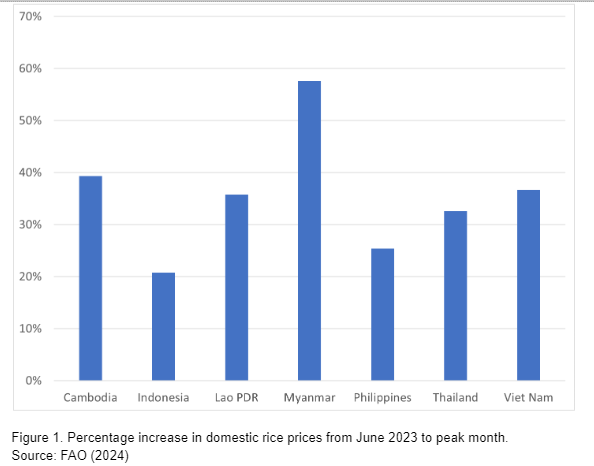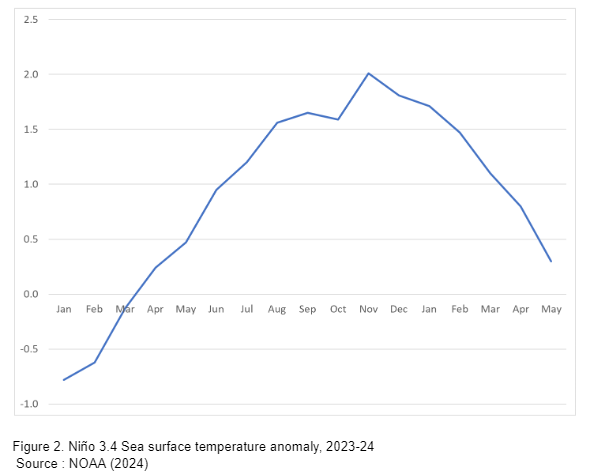by Val Pede and David Dawe
International rice prices have risen substantially. Over the past year, the main factors driving world market prices have been El Niño and the export restrictions from India, the world’s largest rice exporter. Since January 2024, however, prices have declined as El Niño conditions have ended. Fertilizer prices have declined substantially from their peaks in mid-2022 and have stabilized over the past year. These factors give grounds for optimism that international rice prices will stabilize or decline further in the near future.
The world rice market has seen ups and downs during the first few years of this decade. While world wheat and maize prices were on the upswing, more than doubling from August 2020 to May 2022 in the wake of the war in Ukraine, world rice prices were more stable. The Food and Agriculture Organization (FAO) indica rice price index in August 2022 was only 4% above its level in January 2020, the beginning of the COVID-19 pandemic.
However, international rice prices have risen substantially since August 2022, with the FAO indica rice price index increasing by 45% between that time and its peak in January 2024.
Over the past year, the main factors driving indica prices higher on the world market have been weather concerns, particularly El Niño, and export restrictions from India, the world’s largest rice exporter.
El Niño leads to drought in much of Southeast Asia, especially Indonesia and the Philippines. Drought can adversely affect rice production, especially in rainfed areas without irrigation. The United States Department of Agriculture (USDA) projects a decline in rice production in Southeast Asian countries by 1.3 % in 2023/2024, due partially to El Niño.
However, the USDA projects an increase in rice production of slightly less than 1% globally. Furthermore, the ratio of stocks to utilization is healthy, above the average over the past ten years. Thus, overall, at the global level, there is no significant shortage of rice despite some issues with the weather.
Regarding trade policy, it is essential to note that despite India’s restriction on exports of non-basmati non-parboiled rice, exports have continued to flow on a government-to-government basis, although at a reduced pace compared to before the restrictions. The Indian government implemented the plan in response to concerns over the timing of monsoon rains in some parts of the country.
Concerns over a possible fall in production and the higher prices that might result, especially in an election year, led the Indian government to exert greater control over the quantity of rice leaving the country.
El Niño and the export restrictions increased rice prices in domestic markets, particularly in member countries of the Association of Southeast Asian Nations (Figure 1). Higher rice prices raise concerns over food security and nutrition, especially for people experiencing poverty in developing Asian countries, who spend a relatively large proportion of their budget on rice.

When higher prices force poor consumers to spend more of their earnings on rice to maintain dietary energy intake at an acceptable level, they often reduce expenditures on other foods (e.g., meat, fish, fruits, vegetables), education, and health care, thereby jeopardizing their human capital and future adult earnings potential, especially for young children.
Since January 2024, however, the FAO indica price index has declined by 4%. El Niño conditions have now ended (Figure 2), and the National Oceanic and Atmospheric Administration (NOAA) forecasts a high probability of La Niña conditions later this year.

La Niña leads to increased rainfall in Southeast Asia. While this raises the risk of flooding, the additional rain helps refill dams and is generally beneficial for rice production. Fertilizer prices have also declined substantially from their peaks in mid-2022 and have stabilized over the past year. These factors give grounds for optimism that international rice prices will stabilize or decline further in the near future.
Furthermore, domestic prices are now declining in several countries. In May 2024, domestic prices in Vietnam were 6% below their 2023 peak. Further, prices decreased in China, Indonesia, and the Philippines from April to May. While unforeseen events can still occur, the Asian rice economy appears to be stabilizing.






